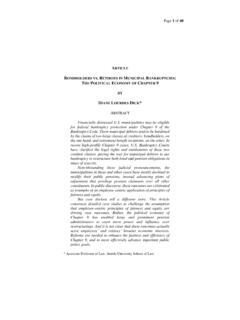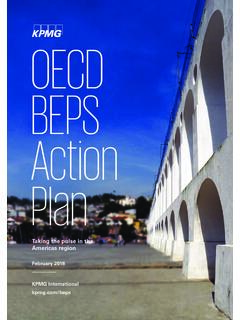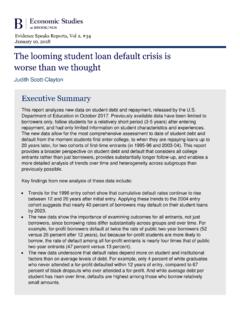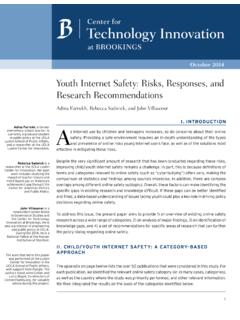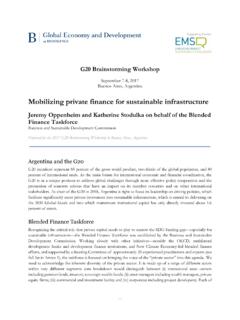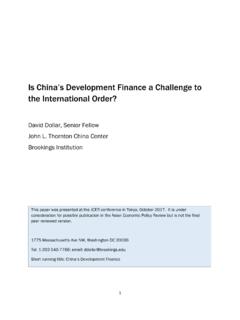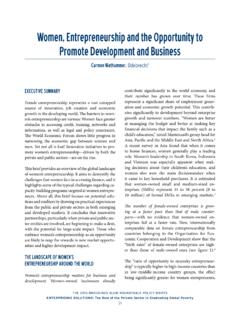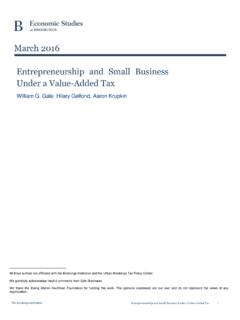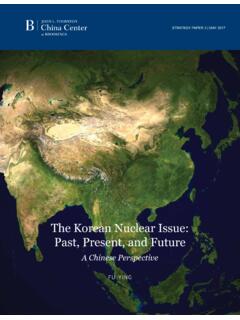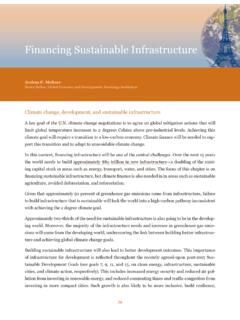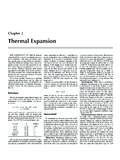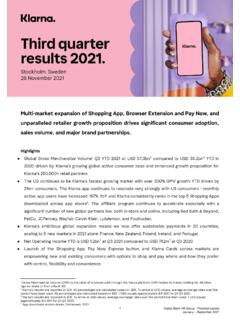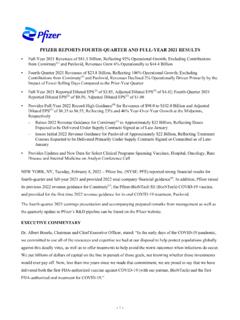Transcription of THE UNPRECEDENTED EXPANSION OF THE GLOBAL MIDDLE …
1 THE UNPRECEDENTED EXPANSION OF THE GLOBAL MIDDLE CLASSAN UPDATEHomi KharasGLOBAL ECONOMY & DEVELOPMENT WORKING PAPER 100 | FEBRUARY 2017 Homi Kharas is a senior fellow and deputy director in the GLOBAL Economy and Development program at the Brookings :I would like to thank Lorenz Noe for his extraordinary and painstaking work in crafting the data base on which this paper relies. Enormously valuable comments were provided by John McArthur and Geoff Gertz. The paper also benefited from comments provided at a presentation made to the 1818 Society Economist :The Brookings Institution is a nonprofit organization devoted to independent research and policy solutions. Its mission is to conduct high -quality, independent research and, based on that research, to provide innovative, prac-tical recommendations for policymakers and the public. The conclusions and recommendations of any Brookings publication are solely those of its author(s), and do not reflect the views of the Institution, its management, or its other scholars.
2 Brookings recognizes that the value it provides is in its absolute commitment to quality, independence and impact. Activities supported by its donors reflect this commitment and the analysis and recommendations are not deter-mined or influenced by any donation. A full list of contributors to the Brookings Institution can be found in the Annual Report at UNPRECEDENTED EXPANSION OF THE GLOBAL MIDDLE class : AN UPDATE 1 THE UNPRECEDENTED EXPANSION OF THE GLOBAL MIDDLE CLASSAN UPDATEHomi KharasINTRODUCTIONS even years ago I published a set of projections suggesting that the emerging MIDDLE class in de-veloping countries was about to surge (Kharas, 2010). I argued further that demand from this segment of the market could drive GLOBAL economic growth and partly offset lower demand among MIDDLE - class consumers in developed countries who were struggling to deal with the shocks to their living standards caused by the Great then, four relevant developments have shaped MIDDLE - class calculations, and the first two of these turn out to have quantitatively important implications for overall estimates of trends and levels.
3 First, a survey of purchasing power parity (PPP) prices, con-ducted in 2011, has replaced the previous 2005 PPP survey (World Bank, 2015) as the basis for comparing real income levels across countries. The 2011 survey differs not just in updating price levels, but also uses a new methodology for generating country-level data. The results have markedly changed and improved our understanding of countries and households relative economic strength. In brief, Asian and African coun-tries were estimated to be far richer, compared to other countries, than previously imagined, by 18 to 26 per-cent in several cases (Deaton and Aten, 2015).The second development has been the continued weakness in GLOBAL economic growth. GLOBAL recov-ery has fallen short of forecasts and remains weaker than the recovery from previous recessions (although perhaps in line with the rate of recovery from previous financial crises).
4 Major institutions have sequentially and continuously downgraded their growth forecasts. The hoped-for green shoots have not materialized. A series of shocks, most recently the collapse of oil and other commodity prices, have reduced income levels in the short run, while deeper analysis of the data has led to a rethinking of long-run potential growth prospects (Summers, 2016; Rachel and Smith, 2015).The third development is the continued improvement of GDP data. In some countries, there has been a rebasing of national accounts leading to significant revisions of estimated output and national income; for example, Nigeria increased its estimate of the size of its economy by more than three-quarters in 2014 (Magnowski, 2014).2 GLOBAL ECONOMY AND DEVELOPMENT PROGRAMF ourth, new household surveys have permitted a more up-to-date assessment of income distribution at a time of significant changes in within-country inequality, and, in some cases, allow for direct measurement of the MIDDLE class for the first purpose of this paper is to assess the impact of these four improvements and the updates to the under-lying data on the evolution of the GLOBAL MIDDLE class .
5 Key findings of the paper include: There were about billion people in the MIDDLE class at the end of 2016, 500 million more than I had previously estimated. This implies that in two to three years there might be a tipping point where a majority of the world s population, for the first time ever, will live in MIDDLE - class or rich households. The rate of increase of the MIDDLE class , in absolute numbers, is approaching its all-time peak. Already, about 140 million are joining the MIDDLE class annu-ally and this number could rise to 170 million in five years time. An overwhelming majority of new entrants into the MIDDLE class by my calculations 88 percent of the next billion will live in Asia. The absolute market size of MIDDLE - class spending is larger than previously estimated. In 2015, mid-dle- class spending was about $35 trillion (in 2011 PPP terms), roughly 12 percent higher than my pre-vious estimate.
6 It now accounts for one-third of the GLOBAL economy. The GLOBAL MIDDLE - class market is now clearly bi-furcated: a slow-growing developed country MIDDLE class , and a fast-growing emerging economy MIDDLE class with growth in both instances measured in terms of either numbers of people or total spending. The most dynamic segment of the GLOBAL MIDDLE - class market is at the lower end of the scale, among new entrants with comparatively low per capita spending. Big geographic distributional shifts in markets are happening, with China and India accounting for an ever-greater market share, while the European and North American MIDDLE class basically stagnates. At a growth of about 4 percent in real terms, the mid-dle- class market is growing faster than GLOBAL GDP growth, but not as fast as it did in the 1960s and 1970s, the boom years for the MIDDLE larger MIDDLE - class population and market has sig-nificant environment and social implications.
7 Naturally, assuming technology does not change, the carbon foot-print per person will rise as the MIDDLE class expands. Two mitigating factors could limit the extent of this. First, MIDDLE - class growth is associated with migration from rural to urban areas and, for a given level of income, households in urban areas tend to have a smaller car-bon footprint than households in rural areas, especially for transport. Second, MIDDLE - class households tend to invest more in their children s education and this, in turn, can reduce fertility rates and decrease the long-term population trajectory for the world. The social implications of a larger MIDDLE class are also important. There is considerable evidence that a larger MIDDLE class will also imply a happier population, at least for new entrants into the MIDDLE class (Kahneman and Deaton, 2010). But there is little evidence to sug-gest that this will create pressures for more democratic governance or for better delivery of public services, both of which are required for sustained growth.
8 In fact, governments may find themselves unable to meet the growing expectations for MIDDLE - class enhancing pro-grams, such as universal health care, public education, pensions, and affordable housing, without resorting to deeply unpopular tax increases. Getting the right bal-ance between taxes on the MIDDLE class and services to support them likely presents the greatest source of uncertainty for this paper s forecasts. THE UNPRECEDENTED EXPANSION OF THE GLOBAL MIDDLE class : AN UPDATE 3 DEFINITION AND METHODOLOGYThe MIDDLE class has been defined by myself and many others, before and since, as comprising those households with per capita incomes between $10 and $100 per person per day (pppd) in 2005 PPP terms (Kharas, 2010; World Bank, 2007; Ernst & Young, 2013; Bank of America Merrill Lynch, 2016).
9 This implies an annual income for a four-person mid-dle- class household of $14,600 to $146, Taking into account inflation, the income range for MIDDLE - class families can now be expressed as $11 to $110 pppd in 2011 PPP terms. I estimate the numbers and spending levels of the MIDDLE class in every country based on household surveys (from which income distribution by country is obtained) and national accounts (from which average household expenditure per person is taken). These es-timates can show the evolution of the MIDDLE class over time. For each country, the assumption is that mean household expenditure will grow at the same rate as real GDP growth per capita. For the period 2017-2021, the International Monetary Fund provides forecasts for real GDP growth (IMF, 2016a). For the period 2021 to 2030, I simply assume the same average growth rate as the IMF envisages for the 9-year period 2012-2021.
10 Within-country income distribution is held constant over the projection periods, with distributional parame-ters estimated from the most recent scenario permits calculation of an annual estimate for the MIDDLE class for each country for each year up to 2030 and, by addition, for the world and other aggregates. The data include 165 countries covering about 97 percent of GLOBAL output and population. The Methodical Approach Section (Page 24) has the full GLOBAL ECONOMY AND DEVELOPMENT PROGRAMDATA IMPROVEMENTS AND UPDATESB elow, I describe the implications of each of the four key data improvements and updates men-tioned above. The magnitude of changes to the data suggests that scenario results should be interpreted with caution and are subject to change as the underly-ing data 2011 PPP dataThe 2011 International Comparison Program contained many innovations to improve the methodology com-pared to the 2005 survey.
